Geology of Pluto

The geology of Pluto consists of the characteristics of the surface, crust, and interior of Pluto. Because of Pluto's distance from Earth, in-depth study from Earth is difficult. Because of this, many details about Pluto remained unknown until 14 July 2015, when New Horizons flew through the Pluto system and began transmitting data back to Earth.[1] When it did, Pluto was found to have remarkable geologic diversity, with New Horizons team member Jeff Moore saying that it "is every bit as complex as that of Mars” [2] The final New Horizons Pluto data transmission was received on October 25, 2016.[3][4]
Surface
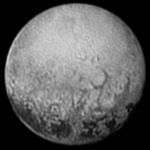
(11 July 2015)
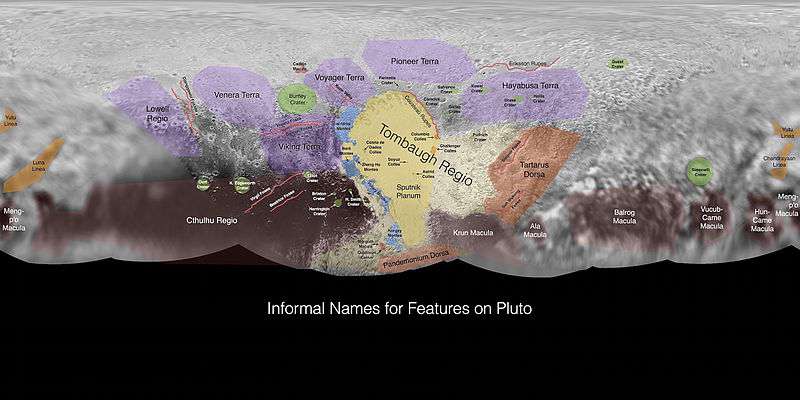
Pluto's surface is composed of more than 98 percent nitrogen ice, with traces of methane and carbon monoxide.[5] The face of Pluto oriented toward Charon contains more methane ice, whereas the opposite face contains more nitrogen and carbon monoxide ice.[6] Distribution of volatile ices is thought to be season-dependent and influenced more by solar insolation and topography than subsurface processes.[7]
Maps produced from images taken by the Hubble Space Telescope (HST), together with Pluto's lightcurve and the periodic variations in its infrared spectra, indicate that Pluto's surface is very varied, with large differences in both brightness and color,[8] with albedos between 0.49 and 0.66.[9] Pluto is one of the most contrastive bodies in the Solar System, with as much contrast as Saturn's moon Iapetus.[10] The color varies between charcoal black, dark orange and white.[11] Pluto's color is more similar to that of Io with slightly more orange, significantly less red than Mars.[12] New Horizons found that Pluto's surface age is equally variable, with ancient, dark, mountainous terrain (such as Cthulhu) being found alongside the bright, flat, effectively craterless Sputnik Planitia and various terrains of intermediate age and color.
Pluto's surface color has changed between 1994 and 2003: the northern polar region has brightened and the southern hemisphere has darkened.[11] Pluto's overall redness has also increased substantially between 2000 and 2002.[11] These rapid changes are probably related to seasonal condensation and sublimation of portions of Pluto's atmosphere, amplified by Pluto's extreme axial tilt and high orbital eccentricity.[11]
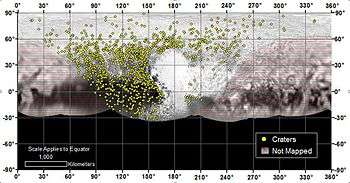
.jpg)
Soft-ice plains and glaciers
Sputnik Planitia appears to be composed of ices more volatile, softer and more dense than the water-ice bedrock of Pluto, including nitrogen, carbon monoxide and methane ice.[13] A polygonal convection cell structure is visible over much of the planitia. No craters have been found, indicating that its surface must be less than 10 million years old.[14] A number of mechanisms are proposed to explain the absence of craters including cryovolcanism, convective overturn, and viscous relaxation - processes that would erase negative topography.[14] Glaciers of what is probably nitrogen ice can be seen flowing from the planitia into adjacent depressions and craters. Nitrogen from the plain appears to have been carried via the atmosphere and deposited in a thin layer of ice on uplands to the east and south of the plain, forming the large bright eastern lobe of Tombaugh Regio. Glaciers appear to be flowing back into the planitia through valleys from these eastern highlands.




|
Water-ice mountains
Mountains several kilometres high have been found along the southwestern and southern edges of Sputnik Planitia. Water ice is the only ice detected on Pluto that is strong enough at Plutonian temperatures to support such heights.
|
Ancient cratered terrain
Cthulhu Regio and other dark areas have many craters and signatures of methane ice. The dark red color is thought to be due to tholins falling out of Pluto's atmosphere.
Northern latitudes
The mid-northern latitudes display a variety of terrain reminiscent of the surface of Triton. A polar cap consisting of methane ice "diluted in a thick, transparent slab of nitrogen ice" is somewhat darker and redder.[17]
|
The western part of Pluto's northern hemisphere consists of an extensive, highly distinctive set of 500-meter-high mountains informally named Tartarus Dorsa; the spacing and shape of the mountains looks similar to scales or tree bark. The method of their formation is unknown, though it has been speculated that they may be composed of methane clathrates that formed in the protosolar nebula.[18] Cutting through both Tartarus Dorsa and Pluto's heavily cratered northern terrain is a set of six canyons radiating from a single point; the longest, informally named Sleipnir Fossa, is over 580 kilometers long. These chasms are thought to have originated from pressures caused by material upwelling at the center of the formation.[19]
Possible cryovolcanism
When New Horizons first sent back data from Pluto, Pluto was thought to be losing hundreds of tons of its atmosphere an hour to ultraviolet light from the Sun; such an escape rate would be too great to be resupplied by comet impacts. Instead, nitrogen was thought to be resupplied by either cryovolcanism or geysers bringing it to the surface. Images of structures that imply upwelling of material from within Pluto, and streaks possibly left by geysers, support this view.[15][20] Subsequent discoveries suggest that Pluto's atmospheric escape was overestimated by several thousand times and thus Pluto could theoretically keep its atmosphere without geological assistance, though evidence of ongoing geology is still strong.[21]
Two possible cryovolcanoes, provisionally named Wright Mons and Piccard Mons, have been identified in topographic maps of the region south of Sputnik Planitia, near the south pole. Both are over 150 km across and at least 4 km high, the tallest peaks known on Pluto at present. They are lightly cratered and thus geologically young, although not as young as Sputnik Planitia. They are characterized by a large summit depression and hummocky flanks. This represents the first time large potentially cryovolcanic constructs have been clearly imaged anywhere in the Solar System.[22][23][24]



Internal structure
Pluto's density is 1.87 g/cm3.[26] Because the decay of radioactive elements would eventually heat the ices enough for the rock to separate from them, scientists think that Pluto's internal structure is differentiated, with the rocky material having settled into a dense core surrounded by a mantle of water ice.[27]
The diameter of the core is hypothesized to be approximately 1700 km, 70% of Pluto's diameter.[25] It is possible that such heating continues today, creating a subsurface ocean layer of liquid water and ammonia some 100 to 180 km thick at the core–mantle boundary.[25][27][28] Studies based on New Horizon's images of Pluto reveal no signs of contraction (as would be expected if Pluto's internal water had all frozen and turned into ice II) and imply that Pluto's interior is still expanding, probably due to this internal ocean; this is the first concrete evidence that Pluto's interior is still liquid.[29] Pluto is proposed to have a thick water-ice lithosphere, based on the length of individual faults and lack of localized uplift. Differing trends in the faults suggest previously active tectonics, though its mechanisms remain unknown. [30] The DLR Institute of Planetary Research calculated that Pluto's density-to-radius ratio lies in a transition zone, along with Neptune's moon Triton, between icy satellites like the mid-sized moons of Uranus and Saturn, and rocky satellites such as Jupiter's Io.[31]
Pluto has no magnetic field.[32]
See also
References
- ↑ Brown, Dwayne; Buckley, Michael; Stothoff, Maria (15 January 2015). "January 15, 2015 Release 15-011 - NASA's New Horizons Spacecraft Begins First Stages of Pluto Encounter". NASA. Retrieved 15 January 2015.
- ↑ http://astronomy.com/news/year-of-pluto/2015/09/new-pluto-images-from-nasas-new-horizons-show-complex-terrain
- ↑ Chang, Kenneth (28 October 2016). "No More Data From Pluto". New York Times. Retrieved 3 December 2016.
- ↑ "Pluto Exploration Complete: New Horizons Returns Last Bits of 2015 Flyby Data to Earth". John Hopkins Applied Research Laboratory. 27 October 2016. Retrieved 3 December 2016.
- 1 2 Owen, Tobias C.; Roush, Ted L.; Cruikshank, Dale P.; et al. (1993). "Surface Ices and the Atmospheric Composition of Pluto". Science. 261 (5122): 745–748. Bibcode:1993Sci...261..745O. doi:10.1126/science.261.5122.745. PMID 17757212.
- ↑ Boyle, Alan (11 February 1999). "Pluto regains its place on the fringe". MSNBC. Retrieved 20 March 2007.
- ↑ Bertrand, T; Forge, F (2016). "Observed glacier and volatile distribution on Pluto from atmosphere-topography processes". Nature. 2016; 000.
- ↑ Buie, Marc W.; Grundy, William M.; Young, Eliot F.; et al. (2010). "Pluto and Charon with the Hubble Space Telescope: I. Monitoring global change and improved surface properties from light curves". Astronomical Journal. 139 (3): 1117–1127. Bibcode:2010AJ....139.1117B. doi:10.1088/0004-6256/139/3/1117.
- ↑ Hamilton, Calvin J. (12 February 2006). "Dwarf Planet Pluto". Views of the Solar System. Retrieved 10 January 2007.
- ↑ Buie, Marc W. "Pluto map information". Retrieved 10 February 2010.
- 1 2 3 4 Villard, Ray; Buie, Marc W. (4 February 2010). "New Hubble Maps of Pluto Show Surface Changes". News Release Number: STScI-2010-06. Retrieved 10 February 2010.
- ↑ Buie, Marc W.; Grundy, William M.; Young, Eliot F.; et al. (2010). "Pluto and Charon with the Hubble Space Telescope: II. Resolving changes on Pluto's surface and a map for Charon". Astronomical Journal. 139 (3): 1128–1143. Bibcode:2010AJ....139.1128B. doi:10.1088/0004-6256/139/3/1128.
- ↑ Lakdawalla, Emily (2015-12-21). "Pluto updates from AGU and DPS: Pretty pictures from a confusing world". The Planetary Society. Retrieved 2016-01-24.
- 1 2 Marchis, F.; Trilling, D. E. (2016-01-20). "The Surface Age of Sputnik Planum, Pluto, Must Be Less than 10 Million Years". PLOS ONE. 11 (1): e0147386. arXiv:1601.02833
 . Bibcode:2016PLoSO..1147386T. doi:10.1371/journal.pone.0147386.
. Bibcode:2016PLoSO..1147386T. doi:10.1371/journal.pone.0147386. - 1 2 Chang, Kenneth (17 July 2015). "Pluto terrain yields big surprises in New Horizons images". New York Times. Retrieved 17 July 2015.
- ↑ Gipson, Lillian (24 July 2015). "New Horizons Discovers Flowing Ices on Pluto". NASA. Retrieved 24 July 2015.
- ↑ "Solar System Exploration: Multimedia: Gallery: Planetary Images: Pluto: The Ice Plot Thickens". NASA. Retrieved 2015-08-11.
- ↑ http://www.space.com/32269-pluto-snakeskin-terrain-solar-system-birth.html
- ↑ http://www.nasa.gov/feature/icy-spider-on-pluto
- ↑ "Scientists study nitrogen provision for Pluto's atmosphere". phys.org. 2015-08-11. Retrieved 11 August 2015.
- ↑ http://pluto.jhuapl.edu/News-Center/News-Article.php?page=20151109
- ↑ "At Pluto, New Horizons Finds Geology of All Ages, Possible Ice Volcanoes, Insight into Planetary Origins". New Horizons News Center. The Johns Hopkins University Applied Physics Laboratory LLC. 2015-11-09. Retrieved 2015-11-09.
- ↑ Witze, A. (2015-11-09). "Icy volcanoes may dot Pluto's surface". Nature News and Comment. Nature Publishing Group. Retrieved 2015-11-09.
- ↑ Redd, N. T. (2015-11-09). "Icy Volcanoes May Erupt on Pluto". Space.Com. Retrieved 2015-11-10.
- 1 2 3 Hussmann, Hauke; Sohl, Frank; Spohn, Tilman (November 2006). "Subsurface oceans and deep interiors of medium-sized outer planet satellites and large trans-neptunian objects" (PDF). Icarus. 185 (1): 258–273. Bibcode:2006Icar..185..258H. doi:10.1016/j.icarus.2006.06.005.
- ↑ Pluto – Universe Today
- 1 2 "The Inside Story". pluto.jhuapl.edu – NASA New Horizons mission site. Johns Hopkins University Applied Physics Laboratory. 2007. Retrieved 11 July 2015.
- ↑ "What is Pluto made of?". Space.com. 20 November 2012. Retrieved 11 July 2015.
- ↑ https://www.newscientist.com/article/2094848-pluto-must-have-liquid-ocean-or-itd-look-like-an-overripe-peach/
- ↑ Moore, Jeffrey (2016). "The Geology of Pluto and Charon through the Eyes of New Horizons". Science. Planetary Science 351.6279: 1284-1293.
- ↑ DLR Interior Structure of Planetary Bodies DLR Radius to Density The natural satellites of the giant outer planets...
- ↑ NASA (14 September 2016). "X-ray Detection Sheds New Light on Pluto". nasa.gov. Retrieved 3 December 2016.






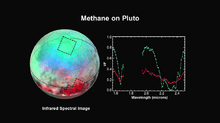


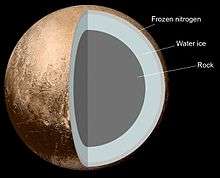

.jpg)